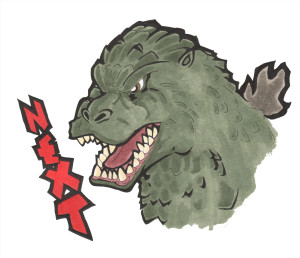- Brain Dead/AKA Dead Alive ~ 1992, Peter Jackson, New Zealand

Before New Line made the ballsiest gamble of the 21st century and entrusted him with directing the entire Lord of the Rings trilogy, Peter Jackson, honorary Hobbit and King Kiwi of the cinematic lexicon, was a handsomely bearded, but little known director, who spent the first phase of his career crafting some of the zaniest splatter films ever made. Like, obnoxiously, unreasonably zany.
It’s worth mentioning this was not necessarily the most hospitable environment for that type of cinema, either, the 1990’s were a bleak and dismal period for horror films on the whole. The genre had enjoyed a reckless hayday in the 1980’s, but by the close of the decade, the market had become saturated, the products dated, and mainstream audiences no longer gave a shit. The once proud horror subculture retreated underground like the primitive Morlocks that they are, and America’s first tier film studios lost faith in tentpole horror franchises of yesteryear, motivating them to move away from the likes of Freddy and Jason, and onto greener pastures, like Ace Ventura 2, Battlefield Earth, and Big Momma’s House. As such, 1992 yielded precious few zombie films, but one that it did produce was Brain Dead, or, as its known in the United States, Dead Alive. Luckily, sometimes it’s quality over quantity, and Dead Alive has quality on lock down.
THE PLOT: Lionel is a meek and unremarkable man who lives with his manipulative, over-baring mother Vera, in a small coastal town somewhere in New Zealand. Lionel is a straight up momma’s boy, Vera has him 200% under her thumb, and he doesn’t appear to have the strength of character to tell her to friggin’ back off now, or ever. In fact, Lionel is so incapable of letting go of his unhealthy relationship with his mother, that when she becomes zombified in a freak primate exhibit accident at the zoo (yep), he does everything in his power to conceal her condition from the public, even going so far as to round up all of her newly zombified victims and keep them hidden away in his basement. Seems like if he had any intention of moving out of his mother’s house, her turning into a homicidal ghoul would be as good a time as any to pull the trigger. Clearly, this birdie ain’t leavin’ the nest.
…But if Lionel won’t ever man up his own, a much needed catalyst arrives in the form of Paquita, a pretty young woman who meets Lionel through coincidence, and who quickly decides that he’s the man she’s going to marry, whether he likes it or not. For a time, Lionel tries to juggle these two relationships, but eventually this becomes infeasible, and he is forced to choose between his controlling, domineering mother, who makes all of his decisions for him… and his controlling, domineering girlfriend…. who makes all of his decisions for him… So, really, this is sort of a long trip to wind up right back where you started, but at least Paquita isn’t a zombie. He for sure upgraded.
Dead Alive’s dodgy super-motif doesn’t bother us. The journey is enjoyable enough that we aren’t deterred by Lionel’s half assed character arc, and the film is silly enough that we assume this lateral development to be deliberate. And anyway, this is easily the most true to life component in the entire film, everybody knows somebody like Lionel, and that guy usually winds up with a Paquita. Most people even know a Vera!

Sadly, few of us have religious leaders like this guy in our lives.
It’s a hell of a movie. For years, Dead Alive was said to be the goriest movie ever made- a boast that’s easy to believe if you see the unrated version of the film. It really feels like if Peter Jackson could have conceived of a way to make this movie gorier, he would have done it. The much coveted “goriest film ever” crown has been snatched up more than once over the years- last I checked, Fede Alvarez’s remake of The Evil Dead is the curent record holder, but I’ll tell you this; Dead Alive still FEELS gorier. In fact, I’ve searched and searched, and no film feels quite as bloody as this one does. No matter how many gallons of red stuff Alvarez dumped onto a sound stage, Dead Alive will trump that volume through it’s execution. Truly, if you have any interest in gore cinema, this needs to be your next stop.
Dead Alive’s 1992 vintage is indeed a rarity. Zombies were sort of in hibernation during this period, meaning that Dead Alive came out after the second wave of zombie fiction, but before the third. More than likely this helps to make the film feel fresher, it’s not really part of any trend, and it’s not really a rehash of anything else, it’s a zombie film that was made because Peter Jackson wanted to tell a zombie story. Really, it’s a rare home run from an era where not many people even cared to swing the bat. If you’re a fan of Jackson’s Hobbit and or magical elf related motion pictures, or if you fancy yourself a fan of zombies, but kinda want to see a film that isn’t a broken mess of lowest common denominator pandering and heat chasing, then do yourself a favor and get this shit on your TV pronto. It’s plenty of fun.
A+







